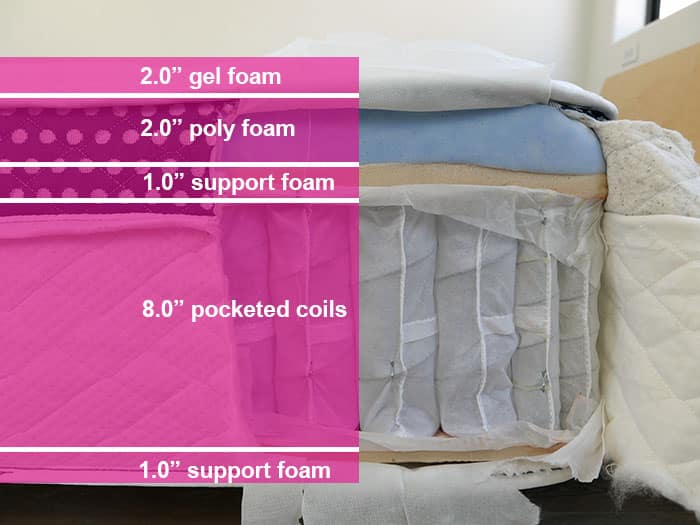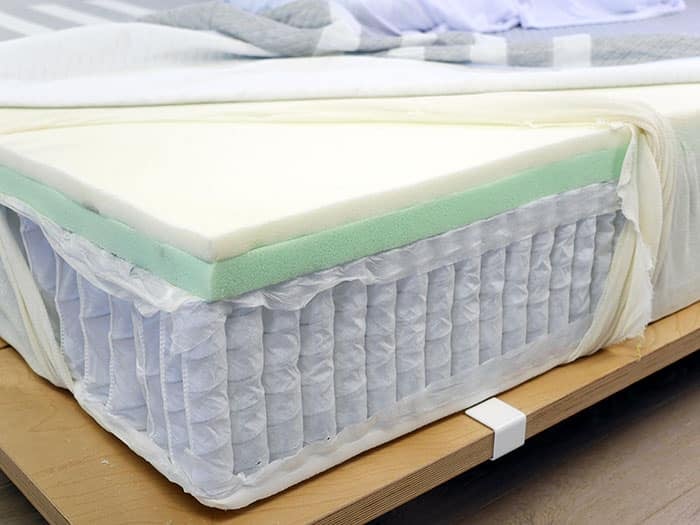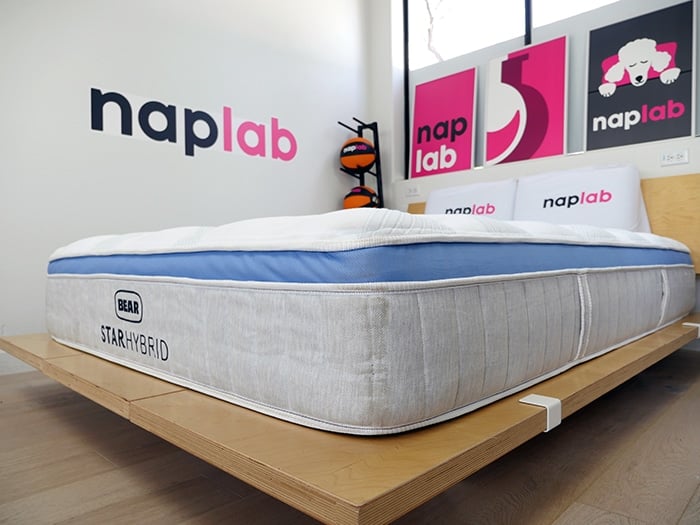Shopping for a mattress isn’t easy, given the different types and designs available. If you can’t decide between a memory foam and an innerspring mattress, consider buying a hybrid model. As the name suggests, hybrid mattresses combine foam and coils, offering the best of both worlds.

A hybrid mattress is suitable for most types of sleepers and typically to lasts longer than many other types of mattress.
Here’s what you should know before buying one.
In This Guide
Design & Materials | Benefits | Drawbacks | Costs | Summary
What is a Hybrid Mattress Made of?
Hybrid mattresses have a foam comfort layer and a coil system, which serves as a support layer. The average foam comfort layer is 4.2” thick (across all mattresses tested to date) and may contain memory foam, latex foam, poly-foam, or a blend of multiple foam types.
The exact design, materials, and thickness may vary from one brand to the next. For instance, some hybrids feature a transitional layer for extra support or use convoluted or hole-punched foams for better breathability. Hybrids may contain anywhere from three to seven separate material layers.
The highest-performing hybrid mattress we have tested to date is the WinkBed Original hybrid, which features five different layers, as illustrated below:

To date, our team at NapLab has tested 192 mattresses. Based on our data, 111 of those mattresses (57.8%) were hybrid, meaning they combined innerspring coils and some kind of foam.
Among the hybrids, 13.5% used memory foam, 16.2% contained latex, and 6.3% were designed for plus-sized sleepers.
The remaining 71 mattresses (64% of all hybrids) used poly foam or a blend of different foams (latex, memory, etc.) and pocketed coils.
For further insights, see our guide to the best hybrid mattresses on the market.
Benefits of Hybrid Mattresses
In one survey, 22% of consumers said they prefer hybrid mattresses. A 2024 NapLab survey of 4,690 sleepers showed that 44% of shoppers are interested in purchasing a hybrid mattress.
What makes them so appealing is their versatility, among other factors.
Let’s take a quick look at their potential benefits:
- Increased airflow: The coils in hybrid mattresses promote airflow, keeping you from overheating at night. Some hybrids also feature cooling technologies that help dissipate body heat.
- Improved responsiveness: Hybrids are often better able to adjust to changes in pressure or movement compared to memory foam or innerspring mattresses. The foam molds to your body’s contours, while the coils create a bouncy feel.
- Enhanced support: The coil system offers robust support and helps distribute your weight evenly. Therefore, you’ll be less likely to get that “sinking feel” associated with memory foam mattresses.
- Pressure relief: Some hybrid mattresses have individual pocket coils that help relieve pressure points. At the same time, you’ll enjoy a plush feel thanks to the foam comfort layer.

- Superior edge support: These types of mattresses often have reinforced edges, resulting in increased stability at the edge of the mattress.

- Durability: Hybrid mattresses are very durable thanks to the built-in coil system and multiple layers. With proper care, they can last 10 to 12 years or longer. By comparison, spring mattresses have an average lifespan of seven to 10 years, whereas foam mattresses can last 10 to 15 years, depending on their quality.

- Good motion isolation: A hybrid mattress with individually wrapped coils can reduce motion transfer during sleep. Ideally, choose one that has multiple foam layers, which can further isolate movement.
Hybrid mattresses also suit most body types and sleeping positions. The coil system makes them ideal for heavier weighted bodies and people who prefer a bouncier feel. Plus, the combination of foam and coil may benefit those with joint or back pain.
Are There Any Drawbacks?
Like most products, hybrid mattresses vary in quality and may not suit everyone.
For example, those with innerspring coils are not as effective at isolating motion as those with pocketed coils. Additionally, cheaper models may trap heat or make squeaking noises when the coils rub against each other.

Hybrid mattresses also weigh more than foam mattresses because of the coil system. Therefore, they are harder to set up and move around.
Due to their weight, they are also quite difficult to rotate. Generally, it’s recommended to rotate your mattresses every few months to ensure even wear and prevent sagging.
Most hybrid mattresses have a one-sided design and, therefore, cannot be flipped. But that’s not always the case. Some brands offer dual-firmnesses, one on each side of the mattress. For a flippable hybrid, check out our reviews of the Propel Dual-Sided Hybrid or the Layla Hybrid.
How Much Does a Hybrid Mattress Cost?
Contrary to popular belief, hybrids are not necessarily more expensive than other mattresses.

Based on our research, the average among all mattresses tested to date is $1,435 for a queen-size model. That includes top-dollar specialty mattresses. If we exclude those, the average queen-size mattress costs around $1,382.
For a hybrid mattress (queen size), the average is $1,352. That’s 2.2% less than what you’d pay for an average mattress.
Specifically comparing hybrid to foam mattresses, the average price for a foam mattress is $1,168. So hybrids are $184 more, on average, but also have a higher average performance score than the average foam mattress.
Is a Hybrid Mattress Worth It?
Whether a hybrid mattress is worth it or not depends on what you expect from it.
This product can be a good choice for couples, hot sleepers, heavier users, and people with joint pain.

However, not all hybrids are created equal—and their quality may vary from one model to another and from brand to brand. A premium hybrid mattress will provide both comfort and support and can last for over a decade.
Our advice is to buy one from a manufacturer or retailer that offers a sleep trial. With this option, you can try out the mattress for 30 days or longer. The average trial period of all mattresses tested to date is 162 nights.
Make sure you also read our guide to the best mattresses. We’ve tested and reviewed 195+ models, including dozens hybrids from top brands.


